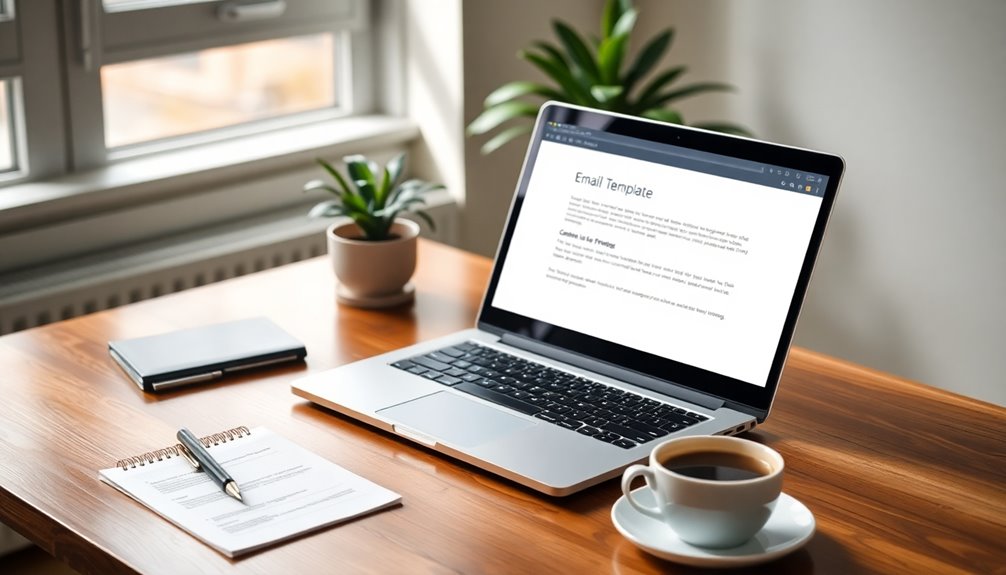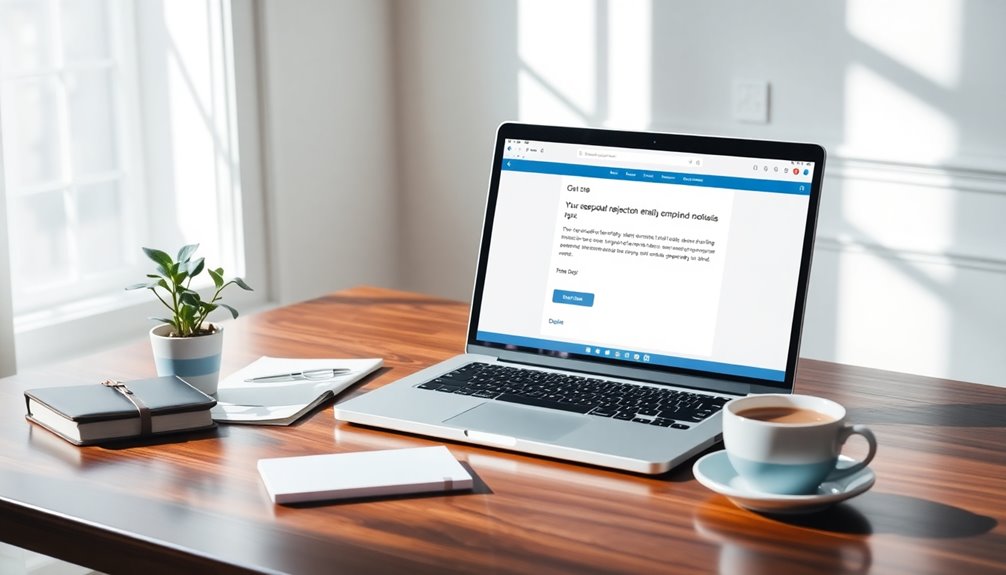To write a clear and effective email, start with a concise subject line that reflects the content, like "Q1 Project Update: Key Insights Inside." Use a formal greeting, then organize your message into short paragraphs or bullet points. This makes it easier to read and understand. Be respectful in your tone, and proofread for errors to maintain professionalism. End with a courteous closing and a clear call to action, such as "Please reply by Friday." If you want more tips to enhance your email writing skills, there's plenty more to discover!
Key Takeaways
- Use a clear and concise subject line under 60 characters to summarize the email content effectively.
- Begin with a formal greeting, addressing the recipient respectfully to establish professionalism.
- Organize the body into short paragraphs or bullet points to enhance readability and comprehension.
- Include a compelling call to action at the end, highlighting benefits and specifying desired responses.
- Thoroughly proofread for spelling and grammar errors to maintain professionalism and clarity in communication.
Introduction

When you sit down to write an email, clarity is your best friend. A professional email starts with a specific subject line that summarizes your main point in less than 60 characters. This grabs the recipient's attention right away.
Use a formal greeting, like "Dear [Name]," to establish a professional tone and show respect in your business communication.
In the body of your email, keep it concise and organized in short paragraphs. Focus on the main message, avoiding unnecessary jargon to ensure clear communication. This makes it easier for your recipient to understand your intent quickly.
Don't forget to include a professional closing statement, such as "Best regards," along with a signature that contains your full contact information. This reinforces your professionalism and provides easy access to your details.
Before hitting send, take a moment to proofread your email for any spelling or grammar errors. This step reflects your attention to detail and commitment to clarity.
Builds Professional Credibility

Crafting clear and effective emails not only conveys your message but also builds your professional credibility. When you use a professional email address that reflects your company or brand, you enhance trust and significantly boost your email's open rates.
A well-structured email subject line is key; it serves as your first impression and can determine if recipients engage with your content. By keeping your subject lines clear and concise, you set the tone for professional communication.
Additionally, addressing recipients by their name and maintaining a professional tone fosters respect and strengthens business relationships. Remember, proofreading emails is crucial. Grammatical errors can undermine your credibility and lead to misunderstandings.
The hard work and dedication you put into crafting a formal letter or business email will pay off in the long run. Implementing A/B testing can help optimize your subject lines and content for better engagement.
Lastly, consistently using a well-designed email signature that includes your full name, title, and contact information reinforces your professionalism. By following these best practices, you'll not only enhance your communication skills but also solidify your reputation in the professional world.
Always aim for clarity and professionalism in every email you send.
Compelling Call to Action

A strong call to action (CTA) is essential for guiding your readers toward the next steps you want them to take. When crafting your email content, use clear and action-oriented language. Phrases like "Please reply by Friday" or "Click here to register for the webinar" specify exactly what you want your audience to do.
Position your CTA strategically at the end of your email to ensure it's easily noticeable. It's important to know that incorporating a sense of urgency, such as "Limited spots available!" or "Offer expires soon," can significantly boost your response rates. Additionally, you may want to consider the financial realignment that recipients may need to undertake after making a decision. To enhance your retirement savings, consider the potential benefits of a Bitcoin IRA for long-term investment growth. This option allows for tax-deferred growth on your investments, further increasing your savings potential.
As an alternative, exploring options like a Gold IRA can provide a hedge against market volatility and inflation.
Highlight the benefits of taking action, showing what your recipient will gain by replying or participating. Keep your CTA concise and straightforward, aiming for a single action to avoid overwhelming your reader. This clarity helps engage them more effectively. Additionally, understanding the concept of investment goals can help tailor your CTA to align with your audience's financial aspirations.
Remember, compelling subject lines can also enhance the overall impact of your email. Whether you're reaching out to potential clients or sending a follow-up email, a well-crafted CTA plays a crucial role in professional business communication.
Step-by-Step Guide for Clarity

Writing clear and effective emails involves a straightforward approach that ensures your message gets across without confusion.
Start by writing a clear subject line that accurately reflects the content of your email. Keep it under 60 characters to maintain brevity and clarity.
Next, use a formal greeting to establish professionalism; address the recipient by their title and last name when applicable.
In the body of your email message, organize your thoughts into concise paragraphs. Present key points in a logical order to enhance readability and comprehension. This structure helps the recipient grasp your message quickly.
At the end of your email, include a clear call to action. Specify any expected responses or next steps, guiding the recipient's actions effectively. This ensures that your intentions are understood and promotes timely responses. Additionally, consider how color accuracy can enhance the clarity of visual communications, especially when sharing presentations or images via email.
Dos and Don'ts for Clarity

Clear communication in emails hinges on knowing what to do and what to avoid. First, always use a clear subject line that summarizes your email's content in 60 characters or less. This enhances readability and boosts open rates.
Maintain a professional tone throughout your message; avoid slang and overly casual language to ensure your message remains respectful.
When crafting your email, focus on key points and actionable items. Don't overload the body with unnecessary information. Instead, use short paragraphs or bullet points for better clarity and organization.
After you've written your concise email, don't forget to proofread for any spelling or grammar errors. Mistakes can undermine your professionalism and lead to misunderstandings.
Examples of Clarification Emails

When you need clarification on a topic, sending a well-structured email can make all the difference. Start with a clear subject line, such as "Request for Clarification on Project X," so the recipient understands the email's purpose immediately.
Begin your message with a polite greeting, like "Hi [Recipient’s Name]," to personalize your communication.
In the body of the email, outline specific points or questions that require clarification. For example:
- Could you explain the timeline for the project milestones?
- What resources are available for our team's work?
- Can you clarify the budget constraints we should consider?
Utilizing clear communication strategies can enhance the effectiveness of your email. Additionally, being aware of small mistakes in wording or tone can prevent misunderstandings. If there's a deadline for the requested information, politely mention it to convey urgency while maintaining professionalism, such as "If possible, I'd appreciate your response by [date]." Additionally, ensure that your email complies with the privacy policy to respect the recipient's data preferences. Including home security factors can provide context if your communication pertains to safety measures or budgeting concerns. Remember, establishing a support network can also help you navigate complex discussions effectively.
Conclude with a courteous closing remark, expressing gratitude for the recipient's assistance. You might say, "Thank you for your help!" and invite further communication, like "Feel free to reach out if you need any additional context."
This approach ensures your email is effective and fosters a collaborative atmosphere.
Pro Tips for Writing Effective Emails

Crafting effective emails is essential for smooth communication. Start with a professional greeting and maintain a respectful tone to foster positive communication. Your subject line will depend on the email's content—make it clear and concise, as specific subject lines can boost open rates by 25%.
In the body of your email, keep your message organized and succinct. Use short paragraphs and bullet points to highlight key points, making it easier for the reader to grasp your message quickly. This approach not only enhances readability but also ensures that your main ideas stand out.
At the end of your email, include a clear call to action. Specify the desired outcomes or next steps to facilitate effective communication. This helps the recipient understand what you expect from them.
Lastly, always proofread your email before hitting send. Check for spelling, grammar, and syntax errors, as well-structured and error-free emails reflect professionalism and attention to detail. Additionally, consider personalization increases engagement as it can significantly enhance the effectiveness of your email campaigns.
Final Thoughts

Effective email communication can significantly enhance your professional relationships and productivity. To craft a clear and effective email, start with a specific subject line that reflects the content, ideally under 60 characters. This helps capture the recipient's attention quickly.
In the body, organize your thoughts into short paragraphs, focusing on key points, and use bullet points for clarity. This approach enhances readability and ensures your message is easily understood.
Maintaining a professional tone is essential; avoid slang and overly casual phrases to respect your recipient and uphold professionalism. Always include a call to action, clearly stating the desired outcome or next steps. This guides the recipient on how to respond or engage further.
Lastly, don't underestimate the importance of proofreading. Check for grammatical errors, ensure clarity, and confirm that all relevant attachments are included. This reflects your attention to detail and professionalism.
Frequently Asked Questions
How Do You Write a Clear and Effective Email?
To write a clear and effective email, start with a concise subject line that reflects your message.
Use a formal greeting and maintain a professional tone throughout.
Structure your email into short paragraphs and utilize bullet points for multiple items.
Conclude with a specific call to action, guiding the recipient on the next steps.
How to Politely Clarify in Email?
To politely clarify in an email, start with a clear subject line that reflects your request.
Greet the recipient warmly, and reference any relevant previous discussions.
Use bullet points to list your specific questions or concerns, ensuring they're easy to read.
Keep your tone courteous, expressing gratitude for their help.
How Do You Write a Perfect Email Example?
To write a perfect email, start with a clear subject line that captures your message's essence.
Use a formal greeting, addressing the recipient by name and title.
Keep the body concise, breaking it into short paragraphs and using bullet points for clarity.
End with a professional closing that reiterates your call-to-action or expresses gratitude.
What Are the 3 C's of Email?
The 3 C's of email are Clarity, Conciseness, and Courtesy.
When you write, aim for clarity by using simple language and a clear structure, avoiding jargon.
Be concise by getting straight to the point and keeping your message short to respect the recipient's time.
Lastly, show courtesy by maintaining a polite tone, using appropriate greetings, and expressing gratitude.
These principles help ensure your emails are effective and well-received.









